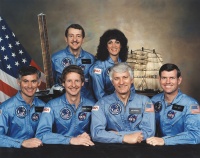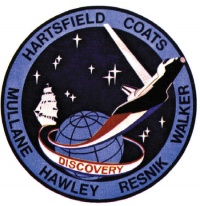STS-41D
From The Space Library
 | |
| Organization | NASA-Office of Space Flight (United States) |
|---|---|
| Mission type | Human Crew |
| Launch date | August 30, 1984 |
| Launch vehicle | Space Shuttle |
| Launch site | Cape Canaveral, United States |
| COSPAR ID | 1984-093A |
| Inclination | 28.45 degrees |
| Experiments | Here |
| Alternate Names | STS 12,15234 |
| Additional Information | Here |
| Data Collection | Here |
| Payload Mass Up | 21524 kg |
| Payload Mass Down | 5134.55 kg |
| Orbiter | Discovery |
| Lift Off Mass | 2,053,424.55 kg |
| Orbiter Weight at Liftoff | 119,762.27 kg |
| Orbiter Weight at Landing | 91,670.00 kg |
| Landed | Runway 17 dry lake bed at Edwards Air Force Base, Calif. |
| Orbits of Earth | 96 |
| Orbital Altitude | 160 nautical miles (184 statute miles) |
Contents |
[edit] Crew
- Commander: Henry Hartsfield Jr.
- Pilot: Michael Coats
- Payload Commander:
- Mission Specialist 1: Richard Mullane
- Mission Specialist 2: Steven Hawley
- Mission Specialist 3: Judith Resnik
- Mission Specialist 4:
- Mission Specialist 5:
- Payload Specialist 1: Charles Walker (as industrial payload specialist representing McDonnell Douglas Corp.)
- Payload Specialist 2:
ISS/Mir Crew Transport
[edit] Mission
STS-41D was the first Discovery shuttle flight. On board were Henry Hartsfield, Michael Coats, Richard Mullane, Steven Hawley, Judith Resnik, and Charles Walker. This mission carried out experiments including OAST-1 solar array structural testing. Three satellites were deployed: Satellite Business System SBS-D, SYNCOM IV-2 (also known as LEASAT2) and TELSTAR. The 102- foot-tall, 13-loot-wide Office of Application and Space Technology (OAST-1) solar wing extended from the payload bay. The wing carried different types of solar cells and extended to full height several times. It demonstrated large lightweight solar arrays for the future in building large facilities in space such as the International Space Station. Other payloads included: Continuous Flow Electrophoresis System (CFES) Ill; Radiation Monitoring Equipment (RME); Shuttle Student Involvement Program (SSIP) experiment; lMAX camera, being flown for the second time; and an Air Force experiment, Cloud Logic to Optimize Use of Defense Systems (CLOUDS). The mission duration was 144 hours 56 minutes 4 seconds.
[edit] EVA
[edit] Payload
Satellite Business System (SBS)-D communications satellite with Payload Assist Module (PAM)-D deployment; Syncom IV-2 communications satellite with its unique stage deployment; Telstar (American Telephone and Telegraph) 3-C with PAM-D deployment; Office of Aeronautics and Space Technology (OAST)-1 experiments; deployment and restowing of large solar array; Continuous Flow Electrophoresis (CFES); IMAX camera. A student experiment, sponsored by Rockwell International, of indium crystal growth using the float zone technique was successful, although a blown fuse resulted in a premature shutdown.
[edit] Books about the Space Shuttle Program
Buy This Book Click here |
Buy This Book here |
Buy This Book Click here |
Buy This Book Click here |





